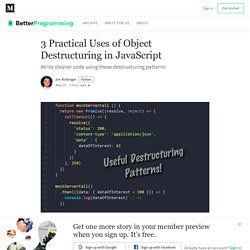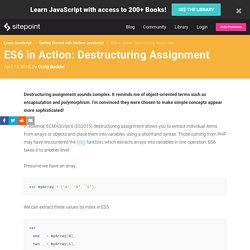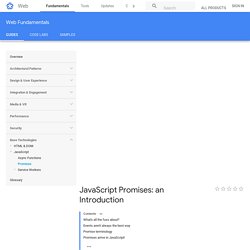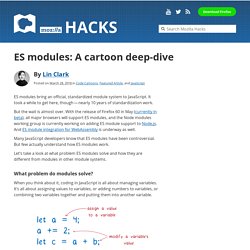ES6+ (ECMAScript 2015+)
JavaScript modules. JavaScript modules are now supported in all major browsers!

Chrome: supported since version 61Firefox: supported since version 60Safari: supported since version 11Node.js: supported since version 13.2.0Babel: supported This article explains how to use JS modules, how to deploy them responsibly, and how the Chrome team is working to make modules even better in the future.
ECMAScript 6: New Features: Overview and Comparison. New ES2018 Features Every JavaScript Developer Should Know. Learn Development at Frontend Masters The ninth edition of the ECMAScript standard, officially known as ECMAScript 2018 (or ES2018 for short), was released in June 2018. Starting with ES2016, new versions of ECMAScript specifications are released yearly rather than every several years and add fewer features than major editions used to. The newest edition of the standard continues the yearly release cycle by adding four new RegExp features, rest/spread properties, asynchronous iteration, and Promise.prototype.finally.
Additionally, ES2018 drops the syntax restriction of escape sequences from tagged templates. These new changes are explained in the subsections that follow. #The Rest/Spread Properties One of the most interesting features added to ES2015 was the spread operator.
ES6 Overview in 350 Bullet Points. Apologies about that long table of contents, and here we go.

ES6 – also known as Harmony, es-next, ES2015 – is the latest finalized specification of the language The ES6 specification was finalized in June 2015, (hence ES2015) Future versions of the specification will follow the ES[YYYY] pattern, e.g ES2016 for ES7 Yearly release schedule, features that don’t make the cut take the next train Since ES6 pre-dates that decision, most of us still call it ES6 Starting with ES2016 (ES7), we should start using the ES[YYYY] pattern to refer to newer versions Top reason for naming scheme is to pressure browser vendors into quickly implementing newest features (back to table of contents) A new primitive type in ES6 You can create your own symbols using var symbol = Symbol() You can add a description for debugging purposes, like Symbol() Symbols are immutable and unique.
Time for a bullet point detox. Then again, I did warn you to read the article series instead.
JavaScript Sets. The Complete Guide to ES10 Features - JavaScript Teacher - Medium. ES10 is no longer just a draft!

All features have already been implemented in major browsers. Here is a non-alien guide for anyone interested in exploring ES10, released June 2019. Follow me on Twitter for JavaScript tips and book announcements.
An intro to the spread operator and rest parameter in JavaScript (ES6)
Both the spread operator and the rest parameter are written as three consecutive dots (…).

Do they have anything else in common? The spread operator was introduced in ES6. It provides you with the ability to expand iterable objects into multiple elements. What does it really mean? Let’s check some examples. const movies = ["Leon", "Love Actually", "Lord of the Rings"];console.log(...movies);
Learn modern javascript in 10 simple ways - Noteworthy - The Journal Blog. Es6 has come to stay, with the cool new features added to javascript developing javascript applications has now become easier and fun.I would like to show you this 10 hot tips that would ease your work flow and help you write modern and efficient JavaScript (less lines of code).

I won’t bore you with less important information, plus you can always read up on es6 if you want. Let’s dive right in. String interpolation before was done with the + operator in javascript, now you can use the template strings `` called backticks and ${variable} to add a variable to the string. This allows you to interpolate variables with strings easily. The backticks button is to left of 1 on the keyboard. //The old wayconst age = 20;let message = 'I am '+age+' years old'; console.log(message); // I am 20 years old // The new waymessage = `I am ${age} years old`; console.log(message); // I am 20 years old If you wanted to exchange the values of two variables say x and y.
The new way is pretty simple.
3 Practical Uses of Object Destructuring in JavaScript. Named arguments are an alternative way to handle function parameters rather than by position.

Instead of ordering your arguments in the same order as the function signature, you simply specify the argument by name. For example, in Python: As you can see, the order of the arguments does not matter — you just specify them by name. The benefits of named arguments vs. positional are: You can leave off one or more parameters when calling the functionOrder does not matter when passing in arguments.More readable code when calling a function that might exist elsewhere While true named arguments do not exist in JavaScript, we can use a destructuring pattern to achieve all 3 of the same benefits.
Learn ECMAScript6 by doing it. ES6 Syntax and Feature Overview. ES6 in Action: Destructuring Assignment. Destructuring assignment sounds complex.

It reminds me of object-oriented terms such as encapsulation and polymorphism. I’m convinced they were chosen to make simple concepts appear more sophisticated!
ES6 Console - try JavaScript compilers. JavaScript Promises: an Introduction
Developers, prepare yourself for a pivotal moment in the history of web development.

[Drumroll begins] Promises have arrived natively in JavaScript! [Fireworks explode, glittery paper rains from above, the crowd goes wild]
A guide to prototype-based class inheritance in JavaScript. The ES6 Guide. ES5 to ESNext — here’s every feature added to JavaScript since 2015. ES6 Console - try JavaScript compilers. Node.js ES2015/ES6, ES2016 and ES2017 support. ES6 Console - try JavaScript compilers. DrkSephy/es6-cheatsheet: ES2015 [ES6] cheatsheet containing tips, tricks, best practices and code snippets.
ECMAScript 6: New Features: Overview and Comparison. JavaScript Modules. Google Developers. Learn ECMAScript6 by doing it. Object-Oriented JavaScript — A Deep Dive into ES6 Classes. Often we need to represent an idea or concept in our programs — maybe a car engine, a computer file, a router, or a temperature reading.

Representing these concepts directly in code comes in two parts: data to represent the state, and functions to represent the behavior. ES6 classes give us a convenient syntax for defining the state and behavior of objects that will represent our concepts. ES6 classes make our code safer by guaranteeing that an initialization function will be called, and they make it easier to define a fixed set of functions that operate on that data and maintain valid state.
If you can think of something as a separate entity, it’s likely you should define a class to represent that “thing” in your program. Consider this non-class code. The date today isn’t valid: there’s no month 24. Here’s the corrected version that uses classes. class SimpleDate { constructor(year, month, day) { this.
ES modules: A cartoon deep-dive – Mozilla Hacks – the Web developer blog. ES modules bring an official, standardized module system to JavaScript.

It took a while to get here, though — nearly 10 years of standardization work. But the wait is almost over. With the release of Firefox 60 in May (currently in beta), all major browsers will support ES modules, and the Node modules working group is currently working on adding ES module support to Node.js. And ES module integration for WebAssembly is underway as well. Many JavaScript developers know that ES modules have been controversial.
Exploring ES2018 and ES2019. Get the book About the book “Exploring ES2018 and ES2019”: Covers what’s new in ECMAScript 2018 and ECMAScript 2019.
If you want to know more about the rest of JavaScript, consult Axel’s other books. About the author. ES2015+ cheatsheet. ECMAScript 6: New Features: Overview and Comparison. Mot-clé - ES6 en détails - Bidouilleux d'Web. Coup d'œil sur ECMAScript 6. JavaScript est une implémentation de ECMAScript, le langage de script standardisé par la norme ECMA-262. La dernière édition publiée de cette norme est la 5.1, qui est supportée par tous les navigateurs web modernes. L’édition 6, baptisée Harmony, est en cours de préparation.
Elle ambitionne d’améliorer notablement le langage et de le rendre plus simple pour écrire des applications complexes.
ECMAScript® 2017 Language Specification. ES8 was Released and here are its Main New Features □
ES2015 Lesson 4: Classes – Zsolt Nagy. The concept of prototypes and prototypal inheritance in ES5 are hard to understand for many developers transitioning from another programming language to JavaScript. ES6 classes introduce syntactic sugar to make prototypes look like classical inheritance. For this reason, some people applaud classes, as it makes JavaScript appear more familiar to them. Others seem to have launched a holy war against classes, claiming that the class syntax is flawed. On some level, all opinions have merit. My advice to you is that the market is always right. I personally use classes on a regular basis, and my React-Redux tutorials also make use of the class syntax.
Not knowing the class syntax is a disadvantage. Judgement on the class syntax, or offering alternatives are beyond the scope of this section.
ECMAScript 6 Tutorial. How to Learn ES6 – JavaScript Scene – Medium. ES Discourse. Node University: Courses on Node.js, React and JavaScript. ECMAScript 6: New Features: Overview and Comparison. "A good programming language is a conceptual universe for thinking about programming.
" — Alan J. Perlis Constants Support for constants (also known as "immutable variables"), i.e., variables which cannot be re-assigned new content. Notice: this only makes the variable itself immutable, not its assigned content (for instance, in case the content is an object, this means the object itself can still be altered). ECMAScript 6 — syntactic sugar: reduced | traditional const PI = 3.141593; PI > 3.0;
Learn ECMAScript6 by doing it. Addyosmani/es6-tools: An aggregation of tooling for using ES6 today.
Learn ES2015 · Babel. Es6features This document was originally taken from Luke Hoban's excellent es6features repo. Go give it a star on GitHub! REPL Be sure to try these features out in the online REPL.
Read Understanding ECMAScript 6. Exploring ES6. Mot-clé - ES6 en détails - Bidouilleux d'Web. ES6 en détails : une introduction - Bidouilleux d'Web. Ce billet est une traduction de cet article, écrit par Jason Orendorff qui participe au développement du moteur JavaScript de Firefox. Ce billet sera le premier d’une série de traductions, chaque billet décrivant une nouvelle fonctionnalité apportée par ECMAScript 6.
ECMAScript 6 compatibility table.
Transpiler/Compiler










